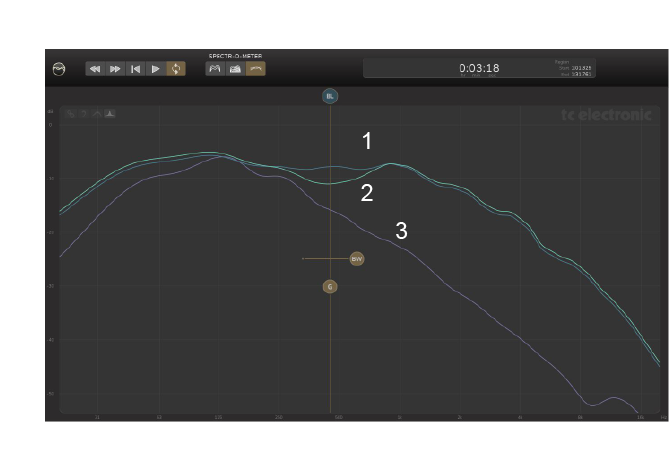Finalizer
Analyzer
Average Spectral Curve (AVG)
AVG is the average energy for each frequency, calculated across the full track. This is very useful for comparing against reference tracks, for example within the same music genre and related album tracks.
All the tracks are loudness normalized during the analysis, which makes it easy to compare the spectrum only. The AVG curves are not affected by the Loudness Compensation in the Monitor section.

Key
- The prepared source (A)
- The processed source (B) with the effects of the various processing modules
- The Reference track imported to the project. All imported Reference tracks will be shown. The selected Reference track will be highlighted. Note that the line colour is the same as the COMPARE buttons, A, B, and REF
Note that the line colour is the same as the COMPARE buttons, A, B, and REF
The EQ overlay can be turned on or off in the AVG display.

The example above shows the “Bell Damp Mids” EQ controls and curve. Note that there is a dip in the B mode curve that corresponds to the lower setting of the Gain control “G.” If no EQ or other processing modules are applied, then the top two curves (A mode and B mode) will be nearly identical.
Note:
- It is important to notice the “nearly identical” A and B in the example above. A spectral change, like with a subtracting EQ, will reduce energy in the affected frequency band. Due to the loudness normalization built into the AVG view, this EQ results in an overall level increase at all other frequencies than the affected band. But that is also how we would hear it and therefore highly relevant when making mastering decisions.
- As “all songs are different” due to the specific instruments being played, the song structure and the mix, it is recommended that you do NOT use the AVG spectrum with an “EQ Match” or “Assimilation” approach. The AVG is however, very useful in a broader view versus related album tracks, or in view of a specific music genre, or to highlight issues with tonal balance. It may hint at an issue worth checking.











